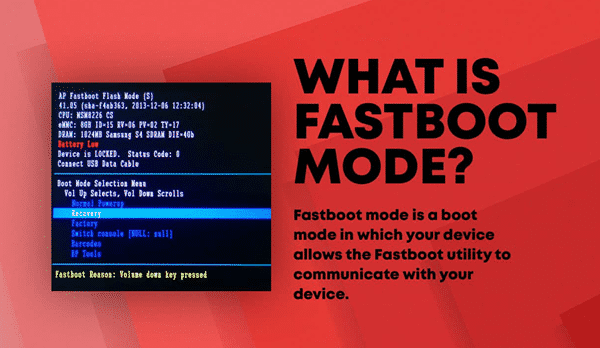
In today's fast-paced digital world, having a thorough understanding of Fastboot is essential for anyone dealing with Android devices. This mode, often overlooked by casual users, plays a crucial role in maintaining and modifying the software of your device. In this detailed guide, we will explore what Fastboot is, how it functions, and why it is a vital tool for developers and advanced users.
What is Fastboot?
Fastboot is a protocol used for writing data directly to your Android device's flash memory. It is an essential part of the Android Debug Bridge (ADB), a tool used by developers and advanced users to communicate with their devices. Fastboot is typically used for tasks such as flashing firmware, kernels, and other system files. It is particularly useful when your device is stuck in a boot loop, or you need to manually install updates or custom ROMs.
When your device is in Fastboot mode, it is essentially in a state where it can receive commands from your computer. This allows you to perform a range of operations that would otherwise be impossible through the standard Android interface.
How to Enter Fastboot Mode
Entering Fastboot mode is relatively straightforward, but the exact method may vary slightly depending on your device's manufacturer. Generally, you can enter Fastboot mode by following these steps:
Turn off your device.
Press and hold the Volume Down button and the Power button simultaneously.
Release the buttons when the Fastboot screen appears.
For some devices, the combination may involve the Volume Up button or a different key sequence. It is always advisable to check the specific instructions for your device model.
Uses of Fastboot Mode
Fastboot mode is an invaluable tool for several critical operations. Here are some of the most common uses:
1. Flashing Firmware
One of the primary uses of Fastboot is to flash firmware on your device. This can be particularly useful if you want to upgrade to a newer version of Android or revert to an older version. Flashing firmware can also help you recover your device if it has become unresponsive or stuck in a boot loop.
2. Unlocking the Bootloader
Before you can install custom ROMs or modify the system, you often need to unlock the bootloader. Fastboot provides a direct way to unlock the bootloader, enabling you to make more extensive changes to your device.
3. Installing Custom Recoveries
Custom recoveries like TWRP (Team Win Recovery Project) allow you to install custom ROMs, create backups, and perform other advanced tasks. Fastboot is the tool that enables you to flash these recoveries onto your device.
4. Updating System Partitions
With Fastboot, you can update specific partitions on your device, such as the system, boot, or recovery partitions. This is particularly useful for developers who need to test changes to the system without flashing a full ROM.
Common Fastboot Commands
When using Fastboot, it is essential to be familiar with some common commands that can help you perform various tasks. Here are a few of the most frequently used commands:
fastboot devices: Lists all devices connected in Fastboot mode.
fastboot flash [partition] [filename]: Flashes the specified partition with the given image file.
fastboot oem unlock: Unlocks the bootloader of your device.
fastboot reboot: Reboots your device out of Fastboot mode.
Advantages of Using Fastboot
Using Fastboot has several advantages, especially for advanced users and developers:
Control Over the System: Fastboot gives you direct control over your device's system, allowing you to make changes that are not possible through the standard Android interface.
Recovery from Boot Loops: If your device is stuck in a boot loop, Fastboot can help you flash the necessary files to get it working again.
Customization: By unlocking the bootloader and flashing custom recoveries, you can install custom ROMs and tweak your device to suit your needs.
Precautions When Using Fastboot
While Fastboot is a powerful tool, it should be used with caution. Here are some precautions to keep in mind:
Data Loss: Some operations, such as unlocking the bootloader, will erase all data on your device. Always ensure you have a complete backup before proceeding.
Bricking the Device: Incorrectly flashing files can result in a bricked device, which is essentially unusable. Always double-check the files you are flashing and ensure they are compatible with your device.
Manufacturer Warranty: Some manufacturers may void your warranty if you unlock the bootloader or flash custom software. It is essential to be aware of the potential consequences before using Fastboot.
Conclusion
Fastboot is an indispensable tool for anyone who wants to take full control of their Android device. Whether you're a developer testing new software or an advanced user customizing your device, Fastboot provides the flexibility and power needed to perform a wide range of tasks. However, with great power comes great responsibility, and it is crucial to use Fastboot with caution to avoid damaging your device.
 Best UI & UX Designing Services | Android & iPhone UI-UX Development in Delhi NCR – Oprezo India
Best UI & UX Designing Services | Android & iPhone UI-UX Development in Delhi NCR – Oprezo India
 Trusted Android App Development & Top Website Development Company in Delhi NCR | Oprezo India
Trusted Android App Development & Top Website Development Company in Delhi NCR | Oprezo India
 Oprezo India – Best Backend Development Company in Delhi NCR
Oprezo India – Best Backend Development Company in Delhi NCR
 Best Web Development Company in Delhi NCR | Oprezo India
Best Web Development Company in Delhi NCR | Oprezo India
 Best Mobile App Development Company in Delhi | Oprezo India
Best Mobile App Development Company in Delhi | Oprezo India